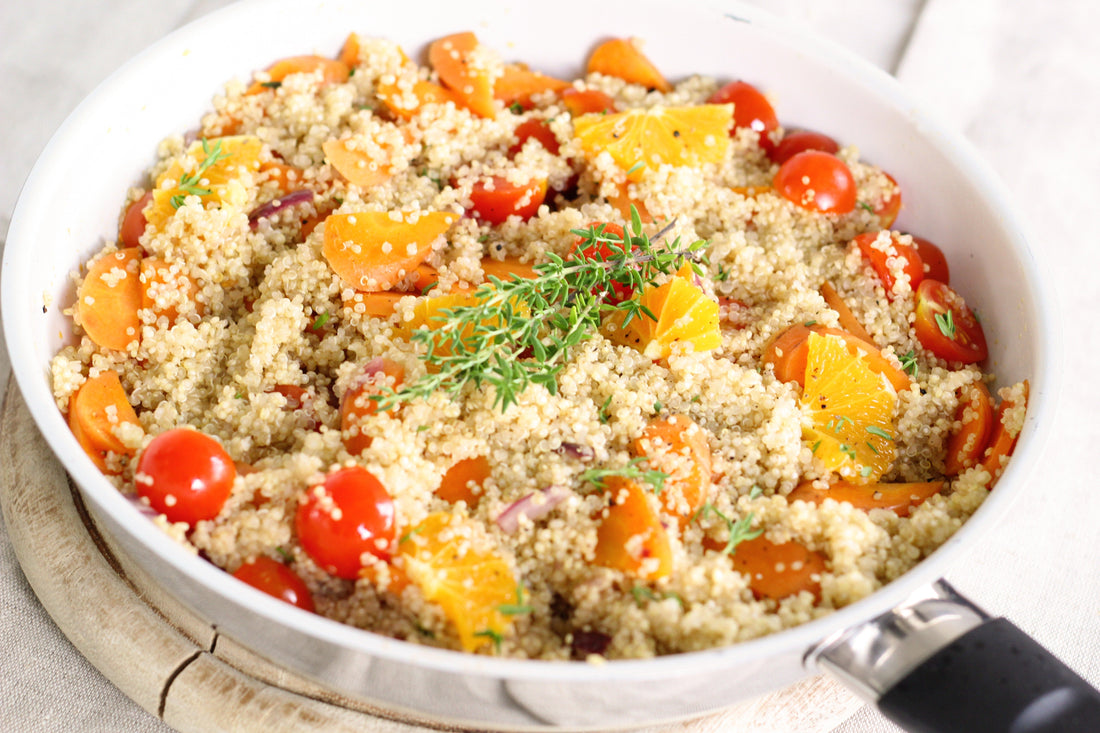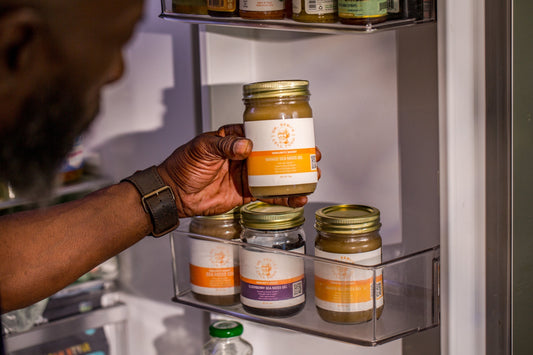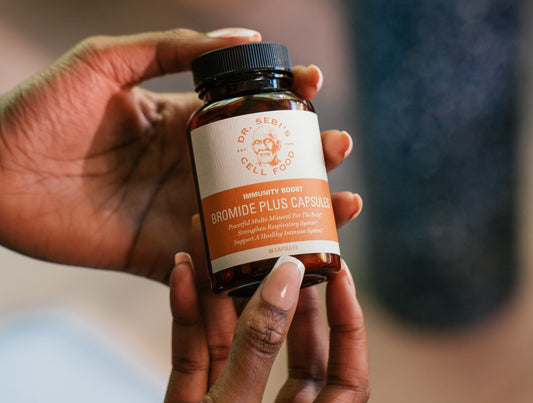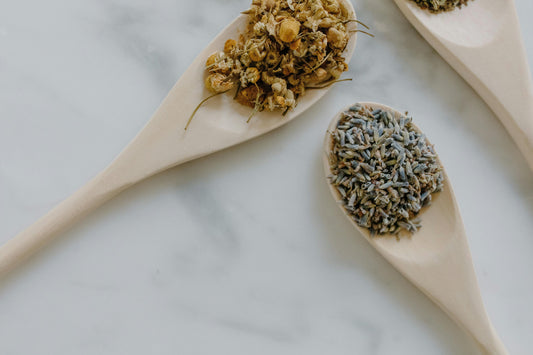As the sunny days of summer give way to the chilly temperatures of autumn, there's also a shift in our culinary cravings toward more comfort food. You can embrace the bounty of the changing seasons with this collection of healthy alkaline recipes for fall.
Drawing inspiration from Dr. Sebi's nutritional philosophy, these recipes celebrate the beauty of all-natural, alkaline-rich ingredients that not only satisfy your taste buds but also nourish your body.
From hearty soups and stews infused with warming spices to wholesome treats that capture the flavors of autumn, find some new fall favorites full of flavor that align with the colorful leaves and crisp air.
Why Focus on Alkaline Foods This Fall?
Eating more alkaline foods isn’t just a fleeting health trend—it’s a delicious and practical way to support your overall well-being, especially as colder weather settles in. According to research published in the Journal of Environmental Health, a diet rich in alkaline foods can help improve gut health. Since many of the nutrients in our modern diets have diminished compared to those of our hunter-gatherer ancestors, prioritizing alkaline foods may help lower the risk of chronic ailments such as diabetes, arthritis, hypertension, and inflammation. It’s also associated with supporting immunity, heart health, healthy weight, and even bone strength.
Doctors may have varying opinions on the specifics of the alkaline diet, but most agree: a plate full of fruits, vegetables, antioxidants, and fiber is always a wise choice—especially compared to processed, high-fat, and overly acidic foods.
Building Your Alkaline Meal Plan
Adopting a high-alkaline approach in the kitchen doesn’t need to be restrictive—think of it as an invitation to get creative with the vibrant flavors each season brings. Start by selecting from a list of high and medium alkaline foods, such as leafy greens, squash, avocados, berries, and root vegetables. Mixing and matching these ingredients allows you to design nourishing meals that support your wellness goals.
With this flexible foundation, you can whip up a colorful array of dishes:
- Smoothies featuring kale, cucumbers, and juicy pears
- Salads with arugula, beets, and crisp apples
- Hearty bowls layered with quinoa, sautéed mushrooms, and roasted vegetables
- Warming soups and stews brimming with lentils, butternut squash, and herbs
While alkaline eating emphasizes minimizing acid-forming foods like processed meats, dairy, eggs, and excess caffeine, it’s all about balance. Honor your comfort foods when a craving arises—enjoying a little of what you love can be just as nourishing as any superfood.
Embracing a Variety of Dietary Lifestyles
One of the joys of alkaline cooking is its natural compatibility with a broad array of dietary preferences. Whether you follow a gluten-free, dairy-free, vegetarian, plant-based, or strictly vegan regimen, most alkaline recipes fit beautifully into your routine. Alkaline-friendly ingredients make it easy to enjoy nutrient-dense meals that align with diverse lifestyle choices.
So, whether you’re experimenting with cutting out gluten, avoiding dairy, or sticking to plants, rest assured that these recipes can seamlessly support your wellness journey this autumn.
Try Dr. Sebi’s Best Alkaline Recipes for Fall
1. Fall Pear Walnut Salad
This delightful recipe incorporates the earthy flavors of fall into a nutrient-rich main or side dish. Pears, rich in dietary fiber, antioxidants, and potassium, contribute to digestive health and support immune function. Tossed in a dressing that blends additional alkaline foods, this salad helps maintain the body's pH balance.
You'll need:
- 1/2 cup walnut halves
- 1/4 cup of agave syrup
- Small pinch of sea salt
- 8 big handfuls of wild arugula
- 2 large pears
- 4 tablespoons of olive oil
- 1/4 cup of key lime juice
Get the full recipe here!
As you explore alkaline eating this season, remember that salads and bowls are a perfect canvas for combining a vibrant mix of alkaline-rich foods. Pears and arugula pair beautifully with the crunch of walnuts, and by focusing on a variety of plant-based, high-alkaline ingredients, you can craft meals that are as nutritious as they are delicious. These combinations not only provide a burst of flavor but also help to support your body’s balance and overall well-being. Try rotating in seasonal produce, nuts, and alkaline-friendly dressings to keep your meal routine exciting and nourishing throughout fall.
2. Fall Apple Crumble
This traditional fall favorite captures the essence of the season, combining the natural sweetness of apples with a hearty crumble topping that nourishes your body (and inner child!).
Apples, known for their fiber, vitamin C, and antioxidant content, promote digestion and heart health. And the walnut-based crumble not only adds a satisfying texture but also provides a source of alkaline-forming goodness.
You'll need:
- 5 organic Braeburn apples
- ¼ teaspoon ground cloves
- Sea salt
- 1 tablespoon date sugar
- ½ cup ground walnuts
- ⅓ cup spelt flour
- ⅓ cup amaranth flour
- ⅓ cup crushed walnuts
- ⅓ cup date sugar
- ⅓ cup grapeseed oil
3. Creamy Vegetable Soup
This comforting soup recipe blends a medley of alkaline-rich vegetables that warms both body and soul. Beyond its soothing taste, the assortment of vegetables, carefully chosen for their high alkaline nature, support balanced pH levels and boost immunity.
You'll need:
- 1 tablespoon grapeseed oil
- 1/4 of a yellow onion
- 1 red bell pepper
- 1 zucchini
- 1 cup homemade walnut milk
- Cayenne pepper
- Sea salt
- Approved herbs (optional)
4. Sauteed Mushrooms and Quinoa With Kale
This recipe marries the earthy richness of sautéed mushrooms with the wholesome nuttiness of quinoa and the vibrant essence of kale.
Mushrooms offer a variety of nutrients and contribute to balanced pH levels. Quinoa, a complete ancient grain, provides sustained energy and nourishment, while kale brings a dose antioxidants as well as folate, fiber, carotenoids, and manganese to support overall health.
You'll need:
- 2 cups quinoa, cooked
- 2 cups mushroom, sliced
- 1 cup kale, chopped
- 1 yellow bell pepper, chopped
- 1 key lime, juiced
- 1 tsp hemp seeds
- 1 tbsp avocado oil
- 1 tbsp olive oil
- Sea salt
Get the full recipe here!
Dishes like this demonstrate how easy it is to incorporate several alkaline-rich foods into one satisfying bowl. By focusing on variety—think leafy greens, ancient grains, legumes, and fresh veggies—you can create meals that are both deeply nourishing and full of flavor. Whether you’re seeking a hearty lunch or a comforting dinner, these kinds of recipes are a wonderful way to enjoy the bounty of the season and prioritize healthful, alkaline eating.
5. Ginger Root Tea
This soothing, fall elixir delivers remarkable health benefits, combining the invigorating properties of ginger with a touch of lime juice and agave syrup for a balanced blend.
Beyond its soothing flavor, ginger is known for its digestive and anti-inflammatory qualities, and lime juice infuses the tea with antioxidants & vitamin C, while agave syrup imparts a gentle sweetness.
You'll need:
- 2 tablespoons of fresh ginger root, roughly 2 inches
- 4 cups of spring water
- 1 tablespoon of fresh key lime juice
- 1-2 tablespoons of pure agave syrup
6. Hearty Mushroom and Zucchini Soup
This nourishing comfort food recipe combines the earthy taste of mushrooms and the crunch of zucchini into a blend that not only satisfies the palate but is also packed with nutrients. Mushrooms, with their immune-boosting properties, provide the main taste and texture, while zucchini brings a refreshing lightness.
You'll need:
- 1 tablespoon grapeseed oil
- 1 medium size onion, chopped
- 1 pound mixed fresh mushrooms (not shiitake), chopped
- 1 medium size zucchini, chopped
- 2 bay leaves
- Sweet basil
- 4 cups homemade vegetable stock
- Sea salt
- Cayenne pepper
7. Creamy Squash and Tomato Soup
This fall dinner recipe combines the velvety texture and sweetness of squash with the tangy essence of tomatoes. Squash offers plenty of nutrients and minerals (like calcium and potassium), contributing to a healthy immune system, while tomatoes infuse the soup with antioxidants and a burst of flavor.
You'll need:
- 1 medium-small butternut squash, unpeeled and quartered
- 2 cups cherry tomatoes
- Grapeseed oil
- 1 onion
- 8 ounces homemade vegetable broth
- Sea salt
- Cayenne pepper
8. Zucchini Pizza Boats
This recipe transforms zucchini into a vessel for the comforting flavors of pizza toppings, offering a medley of health benefits in the process. Zucchini, rich in manganese, lutein, zeaxanthin, and magnesium, which promotes healthy bones, forms the nutritious base, while adding a satisfying crunch.
9. Anti-Inflammatory Veggie Medley
This alkaline-rich recipe combines a diverse array of vegetables to create a nourishing and anti-inflammatory dish. Packed with phytonutrients, minerals, and antioxidants, this medley supports immune health and overall health.
You'll need:
- 4 zucchinis
- 1 cup mushrooms (not shiitake)
- 1/4 cup walnuts
- 1/4 cup chopped onions
- 1/2 teaspoon oregano
- 1 tablespoon of grapeseed oil
- Approved herbs of your choosing
- Sea salt
- Cayenne pepper
10. Banana Bread
Indulge in the wholesome delight of Dr. Sebi's Banana Bread, a nourishing treat that combines taste and well-being in every bite.
Bananas bring natural sweetness and nutrients, including fiber, potassium, magnesium, and manganese, contributing to digestion and heart health. And the spelt flour base imparts a rich texture, supports a healthy pH balance, and promotes overall health.
You'll need:
- 2 cups spelt flour
- 4-5 very ripe burro bananas, mashed (1 1/2 cups)
- 1/2 cup date sugar
- 1/2 cup grapeseed oil
- 2 tablespoons homemade walnut milk
- 1/2 teaspoon salt
- 1/2-1 cup walnuts
11. Spicy Sesame Squash
Delight in the blend of flavors and nourishment with Dr. Sebi's Spicy Sesame Squash, a fall dinner idea that combines the comforting essence of squash with a touch of spice and the richness of sesame.
This dish also boasts a variety of health benefits from squash, which is rich in magnesium and fiber to help support digestive health and immune function.
You'll need:
- 1 medium squash
- 2 tablespoons sesame oil
- 4 tablespoons sesame seeds
- Sea salt
- Cayenne pepper
The Benefits of Eating Alkaline Produce
According to Dr. Sebi, eating foods that are alkaline in nature helps maintain the body’s proper pH balance, promoting overall health and reducing inflammation.
Fall vegetables like squash (chayote squash is one of our favorites!), as well as hearty greens like kale, are rich in essential vitamins, minerals, and antioxidants that help nourish the body. These seasonal foods not only strengthen the immune system but also support digestion, improve circulation, and provide lasting energy.
By incorporating more alkaline fall produce into your diet, you’re not only eating in harmony with the season but also giving your body the nutrients it needs to thrive.
Can Eating Alkaline Foods Help with Health Problems like Diabetes, Arthritis, and Acid Reflux?
Many people have noticed positive changes when they shift to an alkaline-focused diet, especially when managing concerns like diabetes, arthritis, or acid reflux. While opinions among healthcare professionals can differ, there is broad agreement on one key point: building your meals around fresh fruits, vegetables, and other plant-based staples—instead of processed or heavy, acidic foods—supports overall well-being.
Some of the benefits people often report include:
- Better digestion and reduced heartburn or acid reflux symptoms
- More stable energy levels and healthier blood sugar balance
- Less inflammation, which can be helpful for arthritis and other joint concerns
What’s especially important is choosing whole, unprocessed foods and skipping foods high in additives or preservatives. Every body is unique, so tuning in to how your system responds is the best guide. Experiment with these nourishing, alkaline options to discover what helps you feel your best.
Foods to Limit on an Alkaline Diet
When focusing on an alkaline lifestyle, the goal isn’t to follow strict prohibitions but rather to support your body’s balance by making informed choices. Dr. Sebi's nutritional approach encourages you to minimize foods that are considered acidic, as these can disrupt your body’s natural pH equilibrium.
Common foods to reduce or avoid include:
- Meat and poultry
- Dairy products (such as milk, cheese, and yogurt)
- Eggs
- Alcohol
- Coffee and caffeinated beverages
While small indulgences happen, keeping these foods to a minimum allows alkaline produce—to play the starring role in your diet. This shift helps reduce inflammation and supports vibrant health throughout the fall and beyond.
Why Reduce Processed and Acid-Forming Foods?
Limiting processed and acid-forming foods from your daily meals does wonders for your well-being—inside and out. Focusing on whole, natural options like fresh fruits and vegetables supports a balanced pH in the body, which can lower inflammation and contribute to long-term vitality.
A diet centered on fiber-rich, antioxidant-packed ingredients helps lower the risk of health concerns ranging from hypertension and diabetes to digestive discomfort and joint issues. At the same time, steering clear of packaged foods loaded with chemicals, preservatives, and unhealthy fats may reduce your risk of weight gain and promote optimal heart and bone health.
By prioritizing natural, unprocessed foods, you’re giving your body the nourishment it truly craves—and drawing a little closer to vibrant, sustainable energy every day.
"It is the food that you eat that would reconnect you with the energies of life and then words are unnecessary because you could see. You’re reconnected." —Dr. Sebi



















































5 comments
I love the recipes. I wish you had a book available with all of your recipes so I could purchase them, download them or be able to print them out.
Thank you for the great ideas to keep me/husband on track. He loves to eat and I have find ways to try new healthy choices for him/I to eat
Love this please give more recipes.. like that you added the benefits.
Love this please give more recipes.. like that you added the benefits.
Trying to stay healthy, through the fall.